Changes in the Spatial Distribution of the Employed Population in the Yangtze River Delta Region since the 21st Century: An Analysis and Discussion Based on Census Data
Abstract
1. Introduction
2. Materials and Methods
2.1. Data
2.2. Methods
3. Results
3.1. Changes in the Spatial Distribution Characteristics of the Employed Population
3.1.1. Spatial Distribution Characteristics of the Employed Population in 2020
- Resident population density
- Employed population density
3.1.2. Changes in the Centroids of the Spatial Distribution of the Employed Population from 2000 to 2020
3.1.3. Changes in the Spatial Distribution Density of the Employed Population from 2000 to 2020
- Changes in employed population density
- Changes in density of employed population in different industrial sectors
3.2. Cluster Analysis of Change Characteristics Based on 41 Cities
3.2.1. Cluster by Industry Structure
3.2.2. Cluster by Time Stage
3.2.3. Cluster by Spatial Level
4. Discussion
4.1. Regional Differences within the YRD Are Still Significant, but They Are Narrowing
4.2. Different Cities or Regions Show Different Characteristics of Development Stages, and Late-Developing Regions Can Learn from Early Developing Regions
4.3. Metropolitan Areas Are Still the Main Areas of Employment Concentration, and the Spatial Distribution of Employment in Some Cities Is Beginning to Suburbanize
5. Conclusions
Funding
Data Availability Statement
Conflicts of Interest
References
- Shearmur, R.; Coffey, W.J. A Tale of Four Cities: Intrametropolitan Employment Distribution in Toronto, Montreal, Vancouver, and Ottawa-Hull, 1981–1996. Environ. Plan. A Econ. Space 2002, 34, 575–598. [Google Scholar] [CrossRef]
- Coffey, W.J.; Shearmur, R.G. Agglomeration and Dispersion of High-order Service Employment in the Montreal Metropolitan Region, 1981–1996. Urban Stud. 2002, 39, 359–378. [Google Scholar] [CrossRef]
- Alidadi, M.; Dadashpoor, H. Beyond Monocentricity: Examining the Spatial Distribution of Employment in Tehran Metropolitan Region, Iran. Int. J. Urban Sci. 2018, 22, 38–58. [Google Scholar] [CrossRef]
- Bo, W.; Feng, Z. An Analysis of Spatial Distribution of Urban Employment in Nanjing. Hum. Geogr. 2011, 26, 58–65. [Google Scholar]
- Zhan, D.; Zhang, W.; Meng, B.; Dang, Y.; Liu, Q. Spatial Structure of Urban Residence and Employment in Beijing. Sci. Geogr. Sin. 2017, 37, 356–366. [Google Scholar]
- Wei, Z.; Xiao, W.; Qiang, H. Analysis on the Differentiation of Employment Space of Migrant Workers from the Perspective of Gender: An Empirical Study on the Main City of Nanjing. City Plan. Rev. 2017, 41, 54–64. [Google Scholar]
- Li, P. Detecting the Spatial Characteristics of Urban Employment Using Mobile Phone Signaling Data: A Case Study of Shenyang City. Geomat. World 2019, 26, 25–30. [Google Scholar]
- Chen, S.; Feng, Z.; Enyu, C.; Yang, C. Spatial Distribution of New Employment Demand in Nanjing Based on the Data from Zhaopin.com. Econ. Geogr. 2016, 36, 83–90. [Google Scholar]
- Hui, W.; Xiao, W.; Hao, Z. A Preliminary Analysis of the Correlation of Migrant Workers′ Employment Spatial Agglomeration and Urban Employment Space: A Case of Nanjing Main City. Hum. Geogr. 2014, 29, 31–39. [Google Scholar]
- Hui, W.; Xiao, W.; Zheng, H. A Preliminary Analysis of Spatial Distribution of Employment Spatial in Nanjing Main City. Econ. Geogr. 2014, 34, 115–123. [Google Scholar]
- Lao, X.; Shen, W.; Wen, F. A Comparative Research on Employment Density Distribution between Yangtze River Delta and Pearl River Delta. Urban Dev. Stud. 2013, 20, 137–142. [Google Scholar]
- Marelli, E. Evolution of Employment Structures and Regional Specialisation in the EU. Econ. Syst. 2004, 28, 35–59. [Google Scholar] [CrossRef]
- Wang, Z.; Zhu, C. Employment Spatial Models and Regionalization of China. Acta Geogr. Sin. 2007, 62, 191–199. [Google Scholar]
- Gordon, P.; Richardson, H.W.; Wong, H.L. The Distribution of Population and Employment in a Polycentric City: The Case of Los Angeles. Environ. Plan. A 1986, 18, 161–173. [Google Scholar] [CrossRef] [PubMed]
- Small, K.A.; Song, S. Population and Employment Densities: Structure and Change. J. Urban Econ. 1994, 36, 292–313. [Google Scholar] [CrossRef] [PubMed]
- Coffey, W.J.; Shearmur, R.G. Intrametropolitan Employment Distribution in Montreal, 1981–1996. Urban Geogr. 2001, 22, 106–129. [Google Scholar] [CrossRef]
- Baumont, C.; Ertur, C.; Le Gallo, J. Spatial Analysis of Employment and Population Density: The Case of the Agglomeration of Dijon 1999. Geogr. Anal. 2004, 36, 146–176. [Google Scholar] [CrossRef]
- Desmet, K.; Fafchamps, M. Changes in the Spatial Concentration of Employment across US Counties: A Sectoral Analysis 1972–2000. J. Econ. Geogr. 2005, 5, 261–284. [Google Scholar] [CrossRef]
- Guillain, R.; Le Gallo, J.; Boiteux-Orain, C. Changes in Spatial and Sectoral Patterns of Employment in Ile-de-France, 1978–1997. Urban Stud. 2006, 43, 2075–2098. [Google Scholar] [CrossRef]
- Dong, L.; Zhang, P. Spatial Differentiation of Employment Structure in Shenyang City from 1990s. Hum. Geogr. 2008, 23, 32–37. [Google Scholar]
- Zeng, H.; Meng, X.; Li, G. Spatial Structure of Employment and Its Evolution in Shenzhen City: 2001–2004. Hum. Geogr. 2010, 25, 34–40. [Google Scholar]
- Rodríguez-Gámez, L.; Dallerba, S. Spatial Distribution of Employment in Hermosillo, 1999–2004. Urban Stud. 2012, 49, 3663–3678. [Google Scholar] [CrossRef]
- Bindong, S.; Xuhong, W. Spatial distribution and structure evolution of employment and population in Shanghai Metropolitan Area. Acta Geogr. Sin. 2014, 69, 747–758. [Google Scholar]
- Kim, J.I.; Yeo, C.H.; Kwon, J. Spatial Change in Urban Employment Distribution in Seoul Metropolitan City: Clustering, Dispersion and General Dispersion. Int. J. Urban Sci. 2014, 18, 355–372. [Google Scholar] [CrossRef]
- Chen, C. Changes of the Current Chinese Urban and Rural Employment Space and Extended Discussion. City Plan. Rev. 2014, 38, 72–78. [Google Scholar]
- O’Regan, K.M.; Quigley, J.M. Where Youth Live: Economic Effects of Urban Space on Employment Prospects. Urban Stud. 1998, 35, 1187–1205. [Google Scholar] [CrossRef]
- Xu, X. Research on the Evolution Characteristics and Interaction Efficiency of Industrial Structure and Employment Structure in Guangdong Province. Acad. Res. 2009, 90–96. [Google Scholar]
- Sun, T.; Qi, Y.; Liu, X. Changing Intra-Metropolitan Spatial Distribution of Employment with Economic Restructuring in Beijing Metropolitan Area. Econ. Geogr. 2014, 34, 97–104. [Google Scholar]
- Fritsch, M.; Schindele, Y. The Contribution of New Businesses to Regional Employment—An Empirical Analysis. Econ. Geogr. 2011, 87, 153–180. [Google Scholar] [CrossRef]
- Buerger, M.; Broekel, T.; Coad, A. Regional Dynamics of Innovation: Investigating the Co-evolution of Patents, Research and Development (R&D), and Employment. Reg. Stud. 2012, 46, 565–582. [Google Scholar]
- Chang, J.; Cui, L. The Impact of Technological Innovation and Industrial Structure on Employment—Based on Threshold Effect and Spatial Effect. J. Lanzhou Univ. Financ. Econ. 2018, 34, 35–44. [Google Scholar]
- Levernier, W.; Cushing, B. A New Look at the Determinants of the Intrametropolitan Distribution of Population and Employment. Urban Stud. 1994, 31, 1391–1405. [Google Scholar] [CrossRef]
- Sun, T. Spatial mismatch between residences and jobs by sectors in Beijing and its explanations. Geogr. Res. 2015, 34, 351–363. [Google Scholar]
- Zhan, D.; Meng, B. Spatial clustering analysis of residential and employment distribution in Beijing based on their social characteristics. Acta Geogr. Sin. 2013, 68, 1607–1618. [Google Scholar]
- Wang, B.; Wang, L.; Liu, Y.; Yang, B.; Huang, X.; Yang, M. Characteristics of jobs-housing spatial distribution in Beijing based on mobile phone signaling data. Prog. Geogr. 2020, 39, 2028–2042. [Google Scholar] [CrossRef]
- Jia, Y.; Zhen, F. Population and Employment Distribution Characters and the Relationships between them for Small Sized Cities: Case Study of Sihong, Jiangsu. Mod. Urban Res. 2008, 54–62. [Google Scholar]
- Li, H.; Wei, Y.D.; Wu, Y. Urban Amenity, Human Capital and Employment Distribution in Shanghai. Habitat Int. 2019, 91, 102025. [Google Scholar] [CrossRef]
- Holzer, H.J.; Quigley, J.M.; Raphael, S. Public Transit and the Spatial Distribution of Minority Employment: Evidence from a Natural Experiment. J. Policy Anal. Manag. 2003, 22, 415–441. [Google Scholar] [CrossRef]
- Jiao, H.; Hu, J. Spatial Match Between Employment and Housing in Wuhu City, Anhui Province of China. Sci. Geogr. Sin. 2011, 31, 788–793. [Google Scholar]
- Appold, S.J. The Impact of Airports on US Urban Employment Distribution. Environ. Plan. A Econ. Space 2015, 47, 412–429. [Google Scholar] [CrossRef]
- Wang, D.; Li, D.; Fu, Y.Z. Employment space of residential quarters in Shanghai: An exploration based on mobile signaling data. Acta Geogr. Sin. 2020, 75, 1585–1602. [Google Scholar]
- Sun, P.J.; Xiu, C.L. Coupling Degree Assessment of the Man-Land Coupling System of the Mining City from the Vulnerability Perspective. Areal Res. Dev. 2010, 29, 75–79. [Google Scholar]
- Ren, Y.W.; Cao, W.D.; Zhang, Y.; Su, H.F.; Wang, X.W. Temporal and Spatial Coupling Characteristics of Urbanization and Ecological Environment of Three Major Urban Agglomerations in the Yangtze River Economic Belt. Resour. Environ. Yangtze Basin 2019, 28, 2586–2600. [Google Scholar]
- Hong, G.; Lan, C. Coupling Analysis of Urban Construction Land and Urban Population in the Yangtze River Delta. Popul. Soc. 2020, 36, 40–48. [Google Scholar]
- Zhou, Y.; Huang, X.; Xu, G.; Li, J. The coupling and driving forces between urban land expansion and population growth in Yangtze River Delta. Geogr. Res. 2016, 35, 313–324. [Google Scholar]
- Chen, Q.; Tang, J. The Spatial and Characteristics of Population Evolution and Its Dynamic Mechanism in City-and-Town Concentrated Areas in the Yangtze River Delta. J. Zhejiang Univ. Technol. Soc. Sci. 2009, 8, 27–33. [Google Scholar]
- Population Census Office under the State Council; Department of Population and Social Science and Technology Statistics, National Bureau of Statistics. Tabulation on the 2010 Population Census by County; China Statistics Press: Beijing, China, 2003.
- Population Census Office under the State Council; Department of Populationand Employment Statistics, National Bureau of Statistics. Tabulation on the 2010 Population Census of the People’s Republic of China by County; China Statistics Press: Beijing, China, 2012.
- Office of the Leading Group of the State Council for the Seventh National Population Census. Tabulation on 2020 China Population Census by County; China Statistics Press: Beijing, China, 2022.
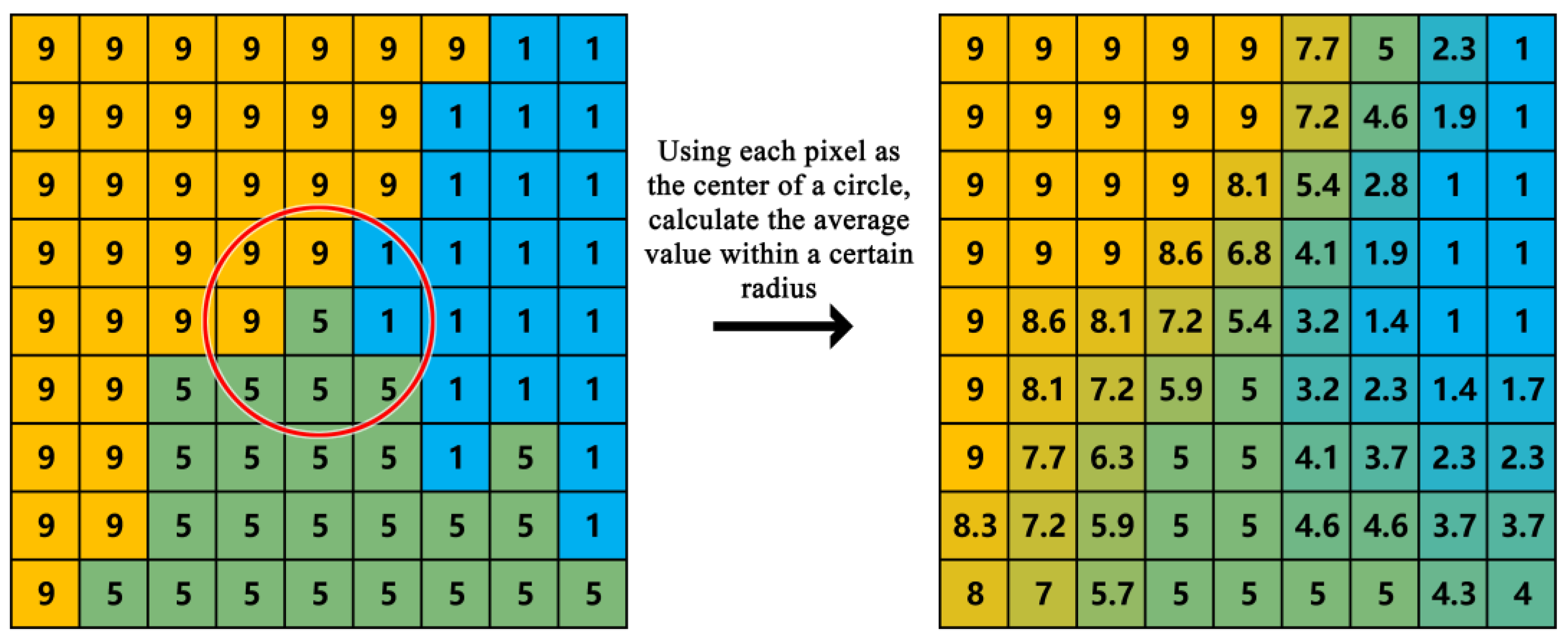
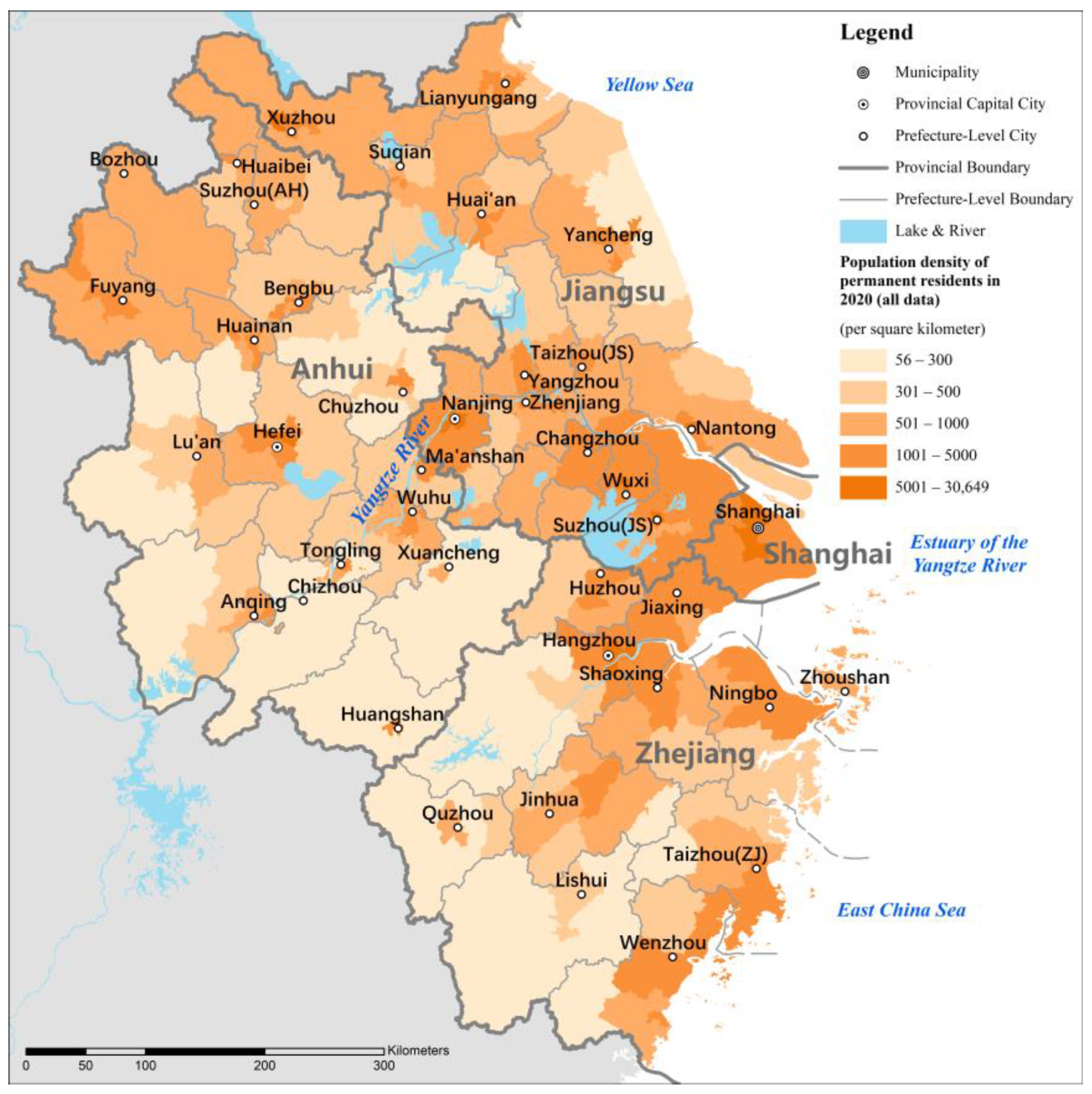

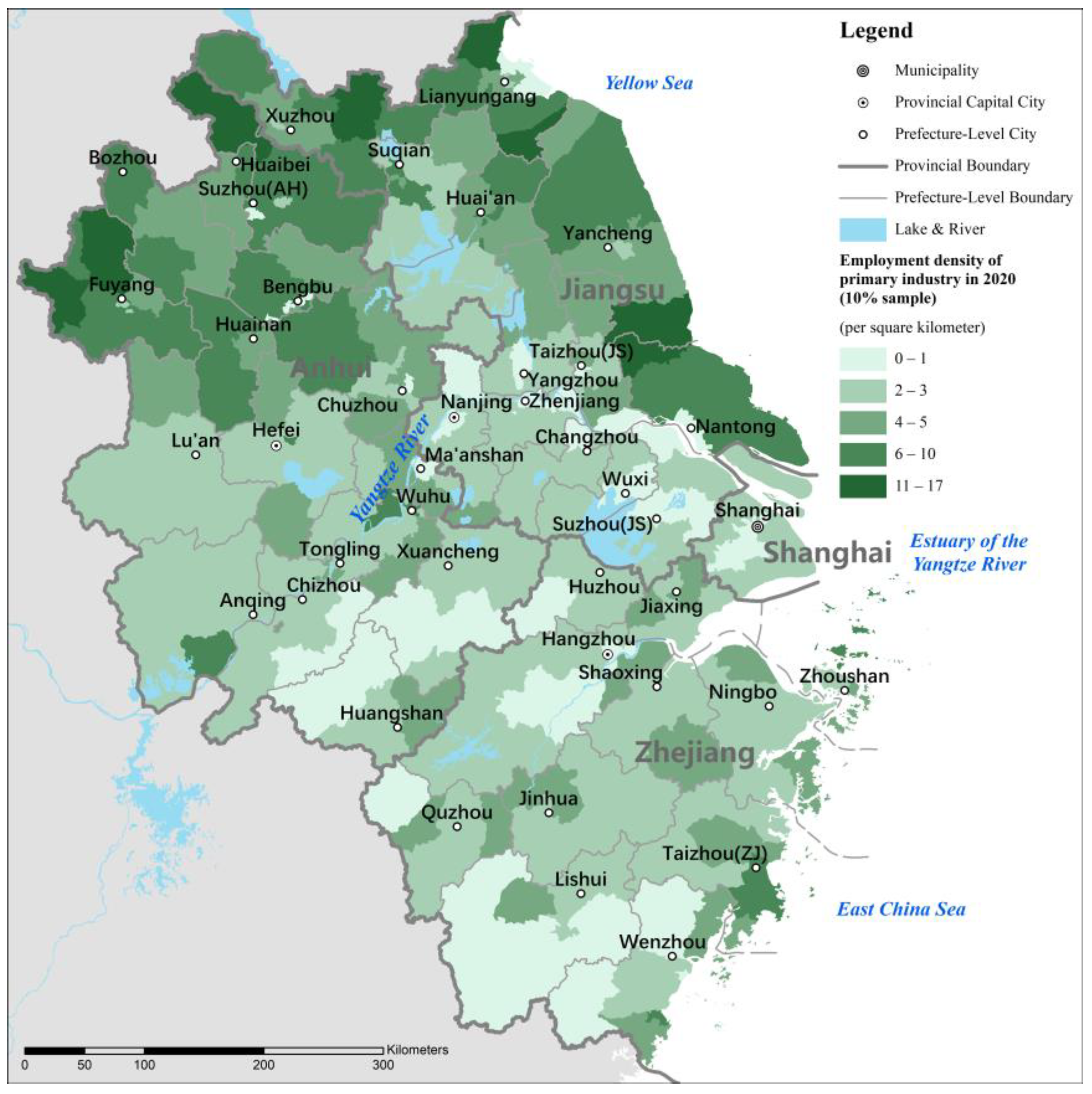
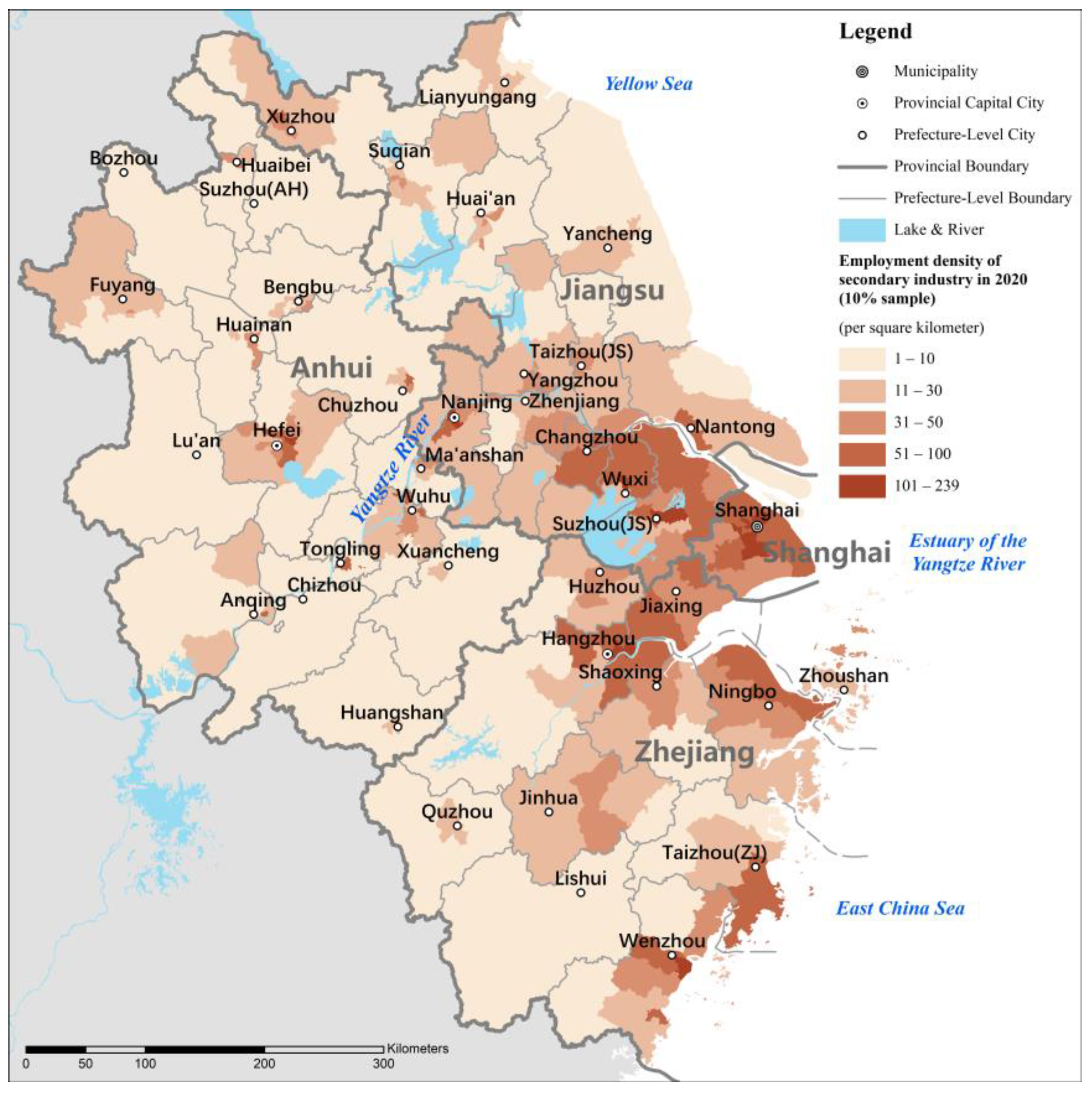
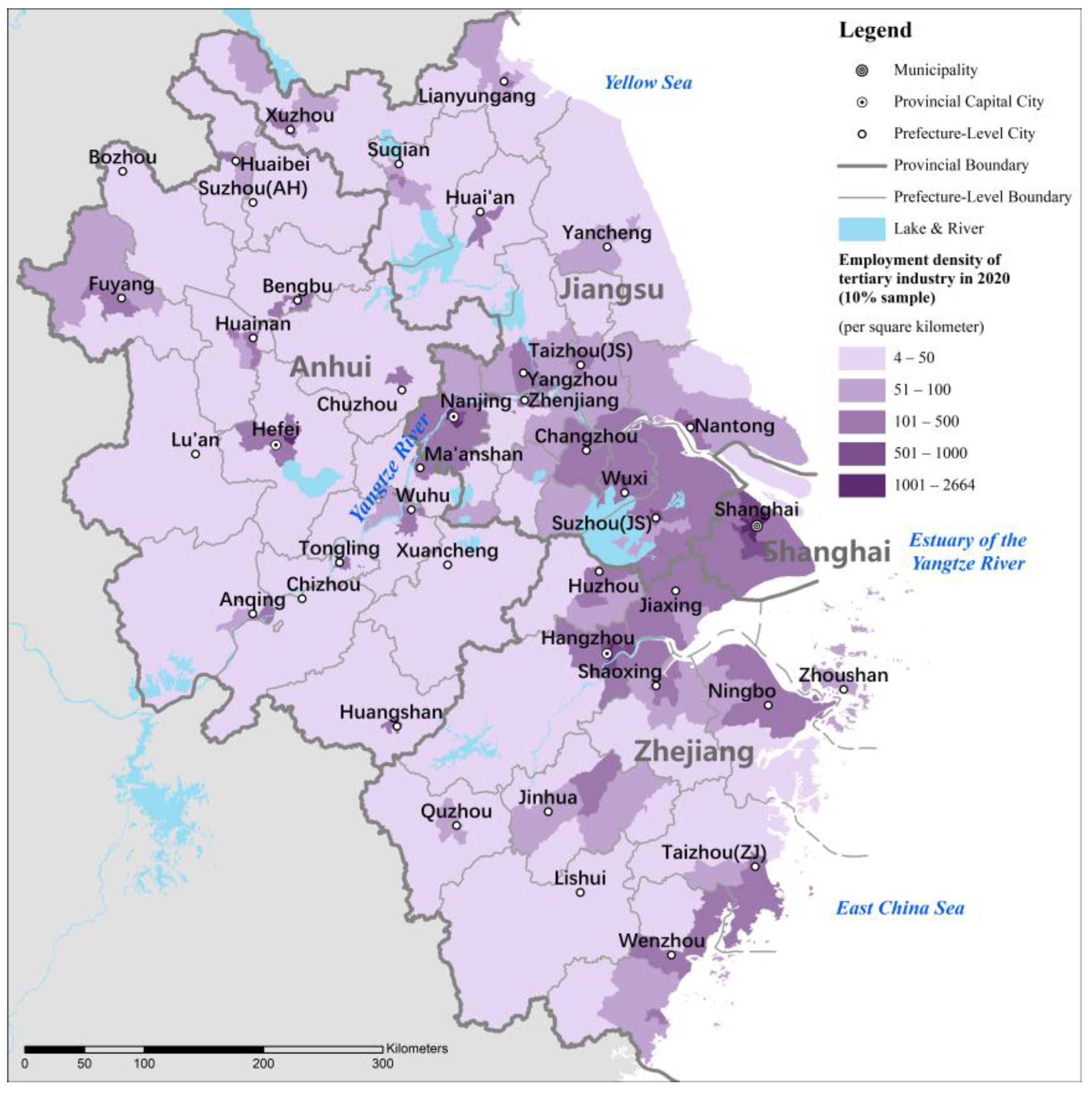
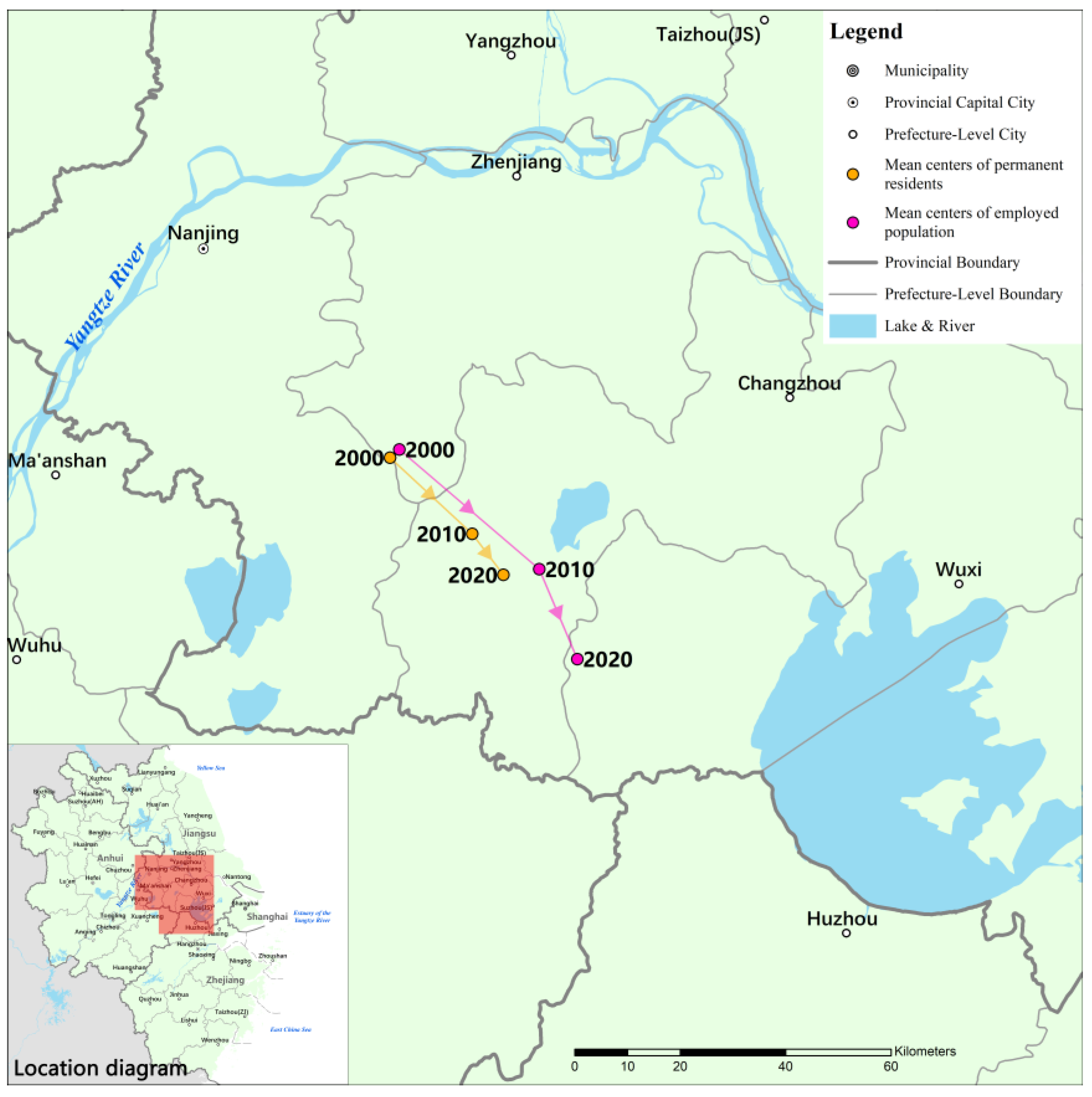
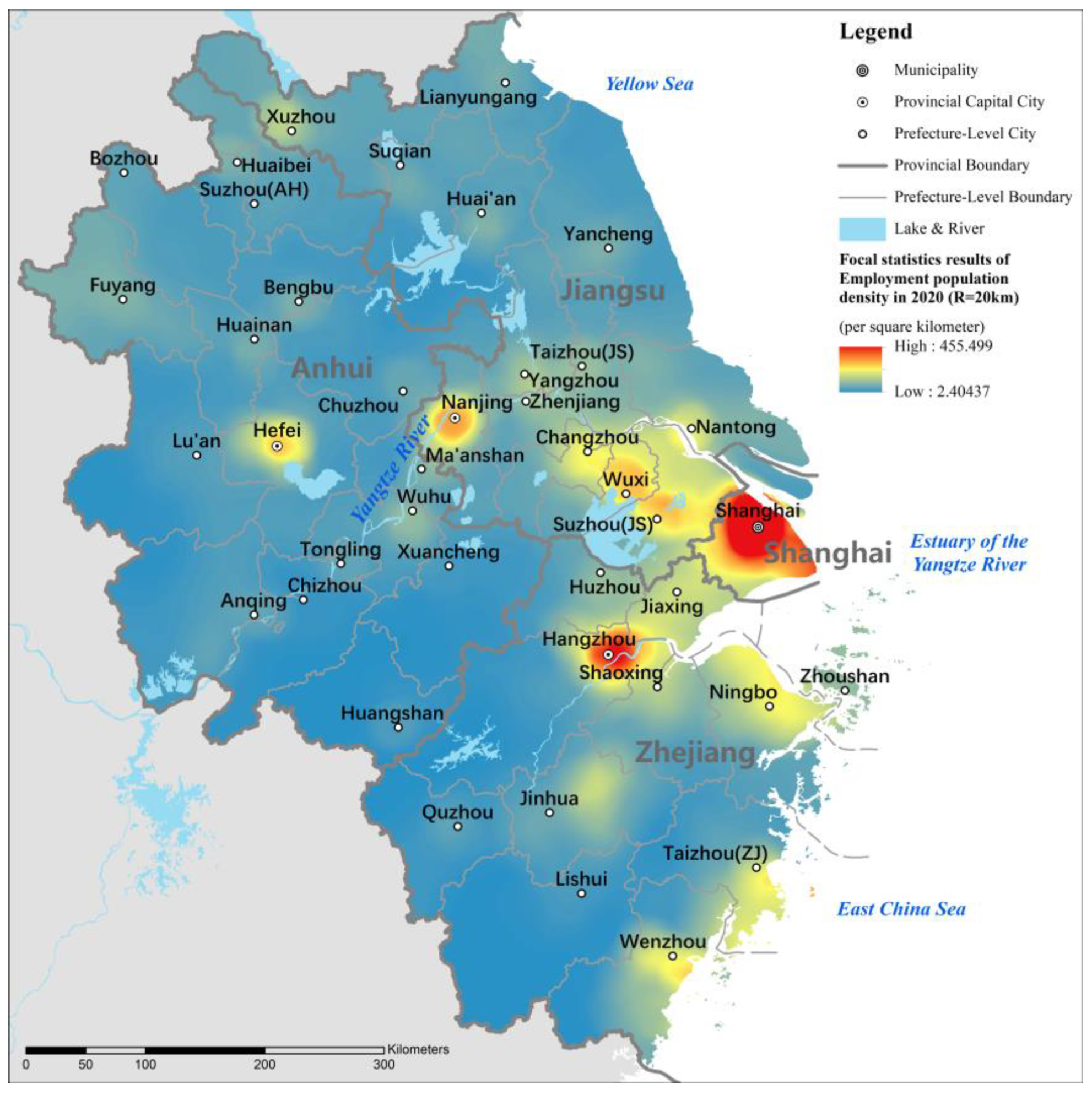

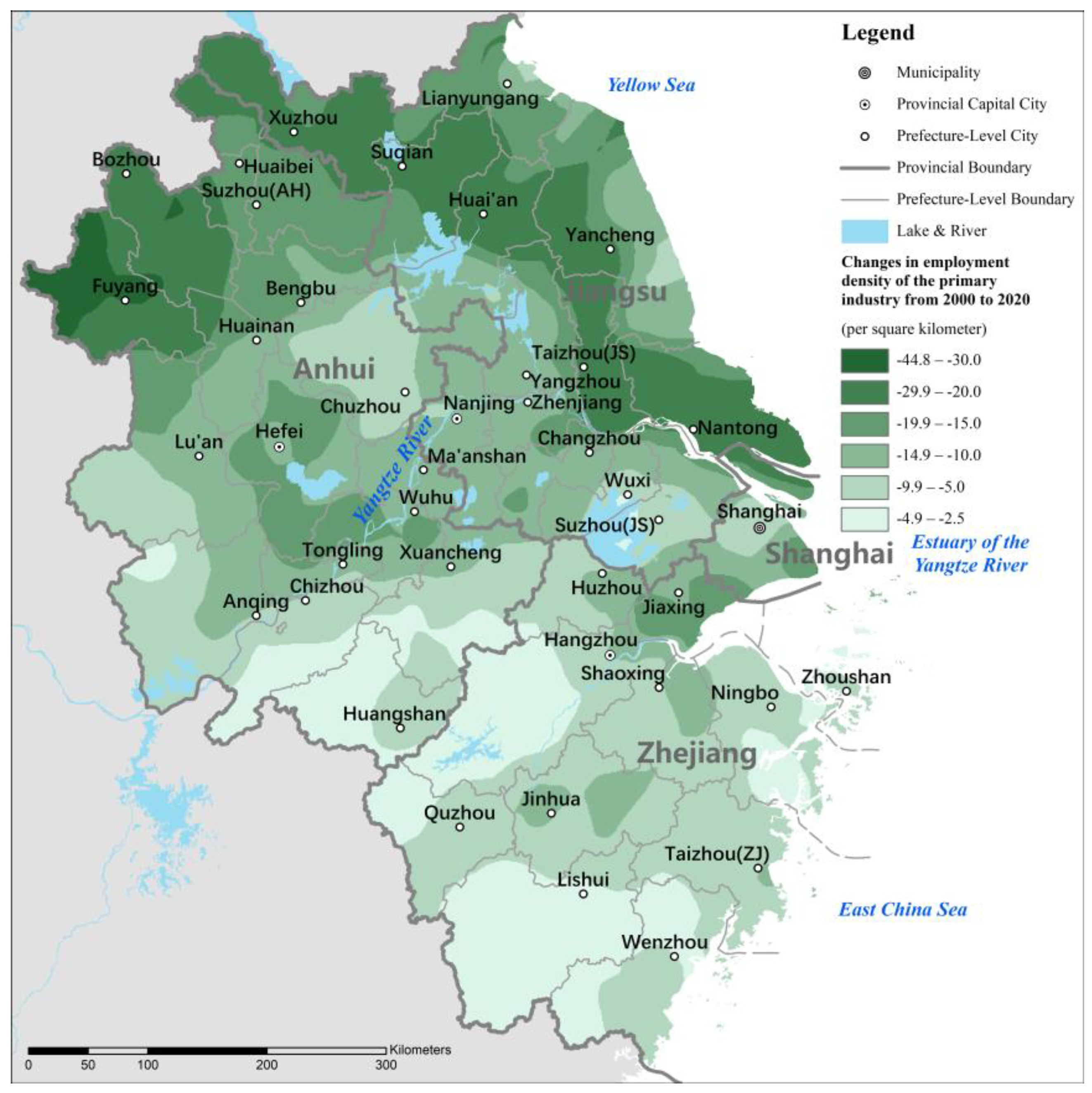
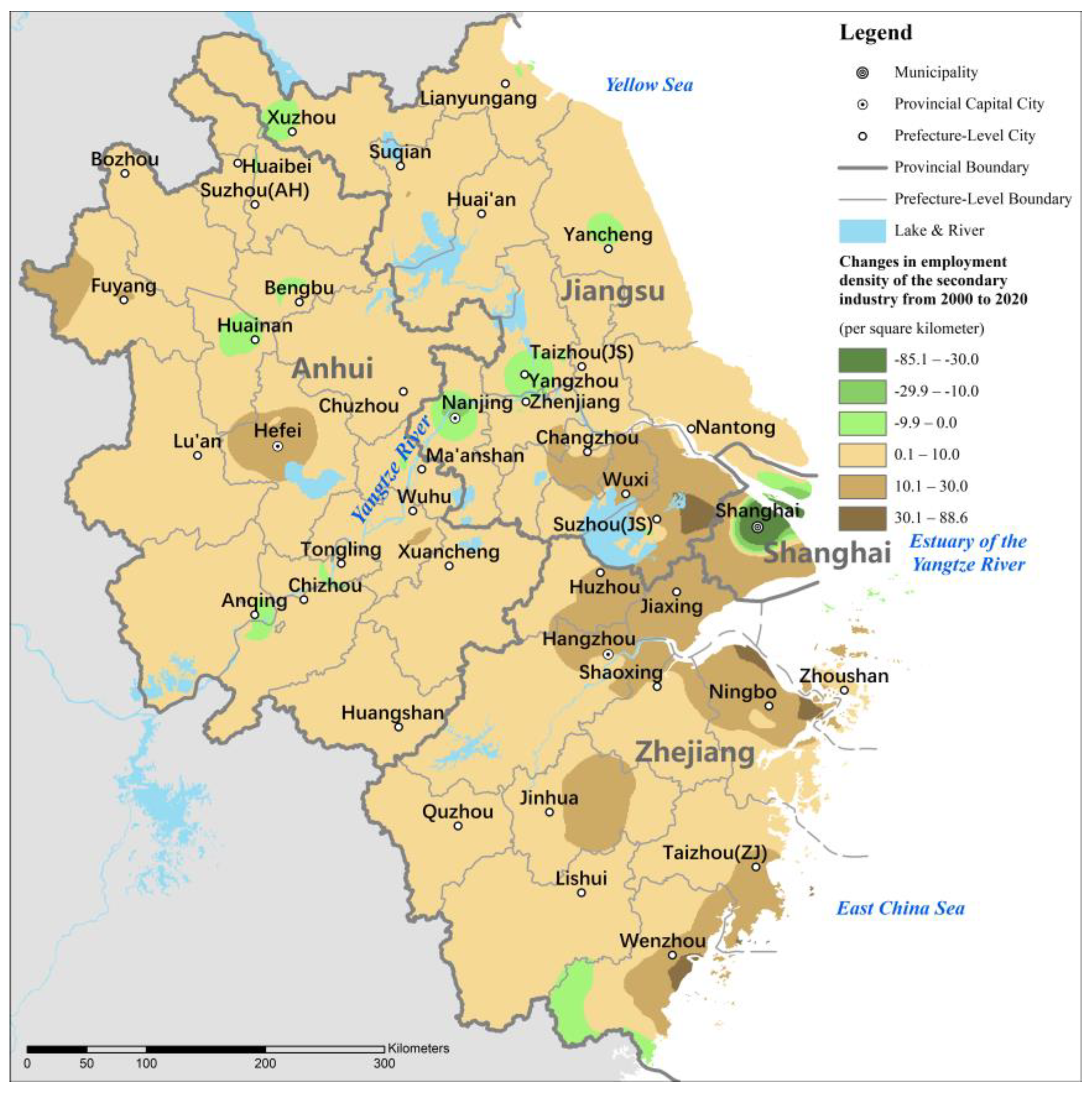
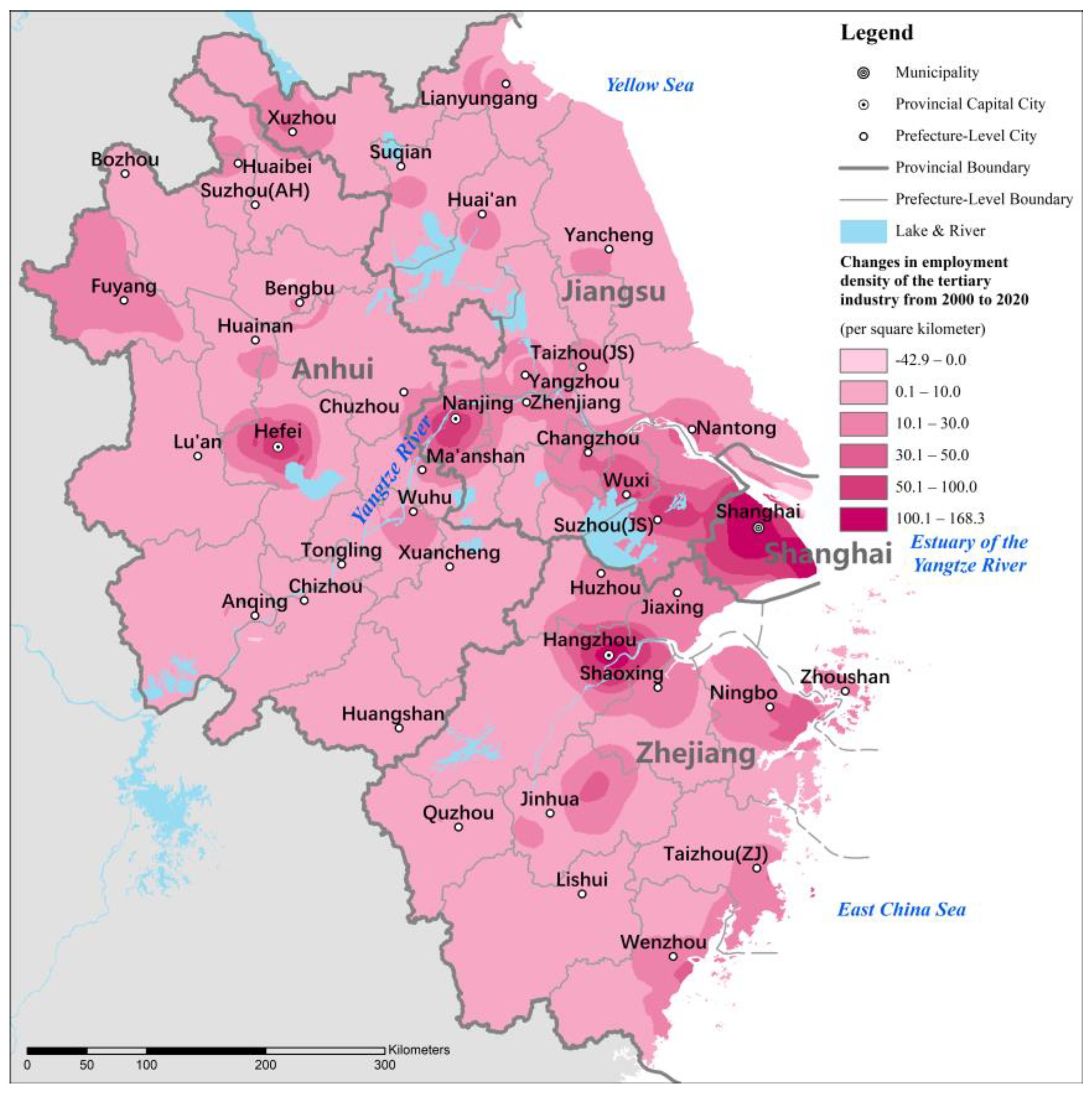

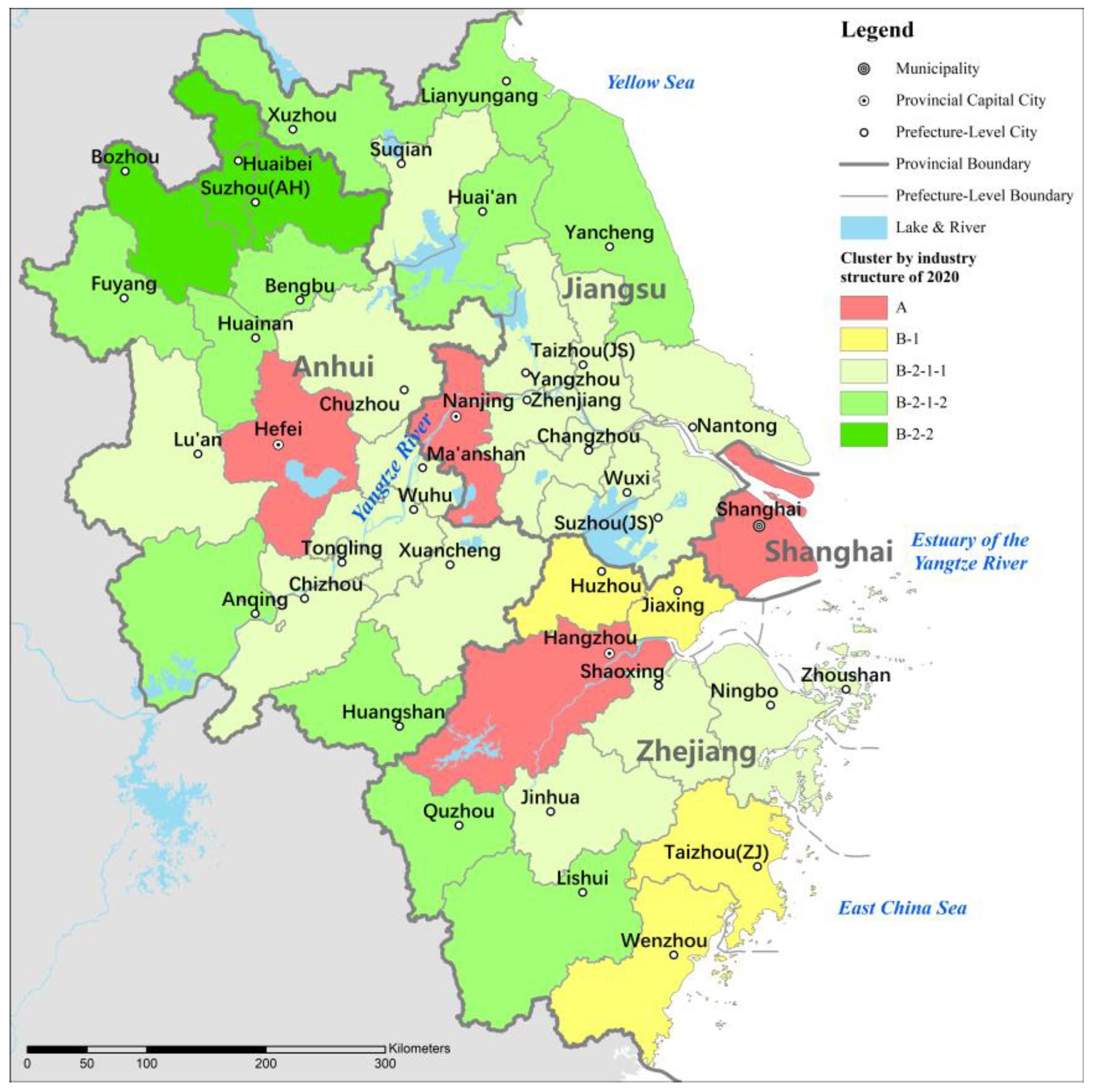

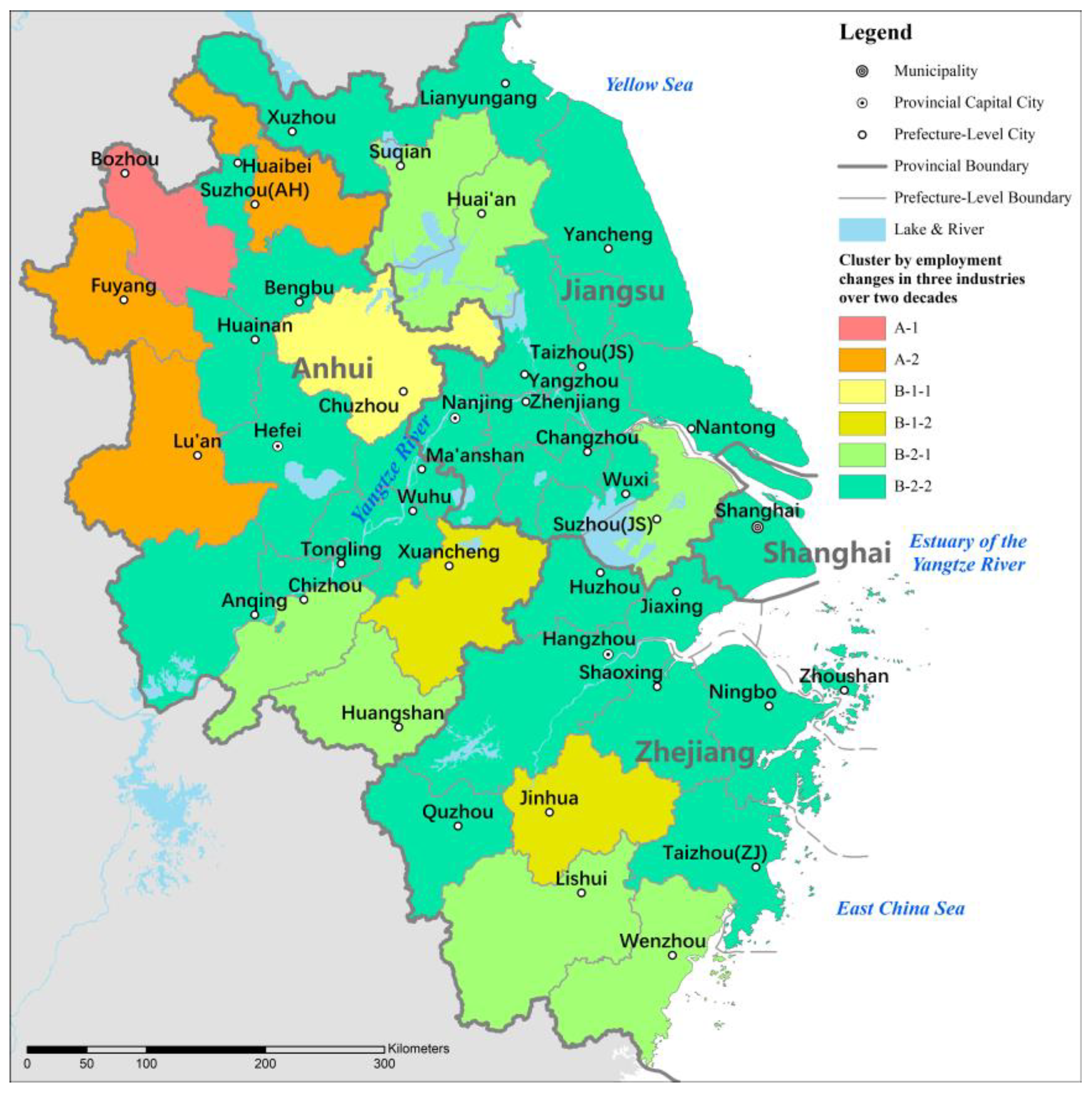
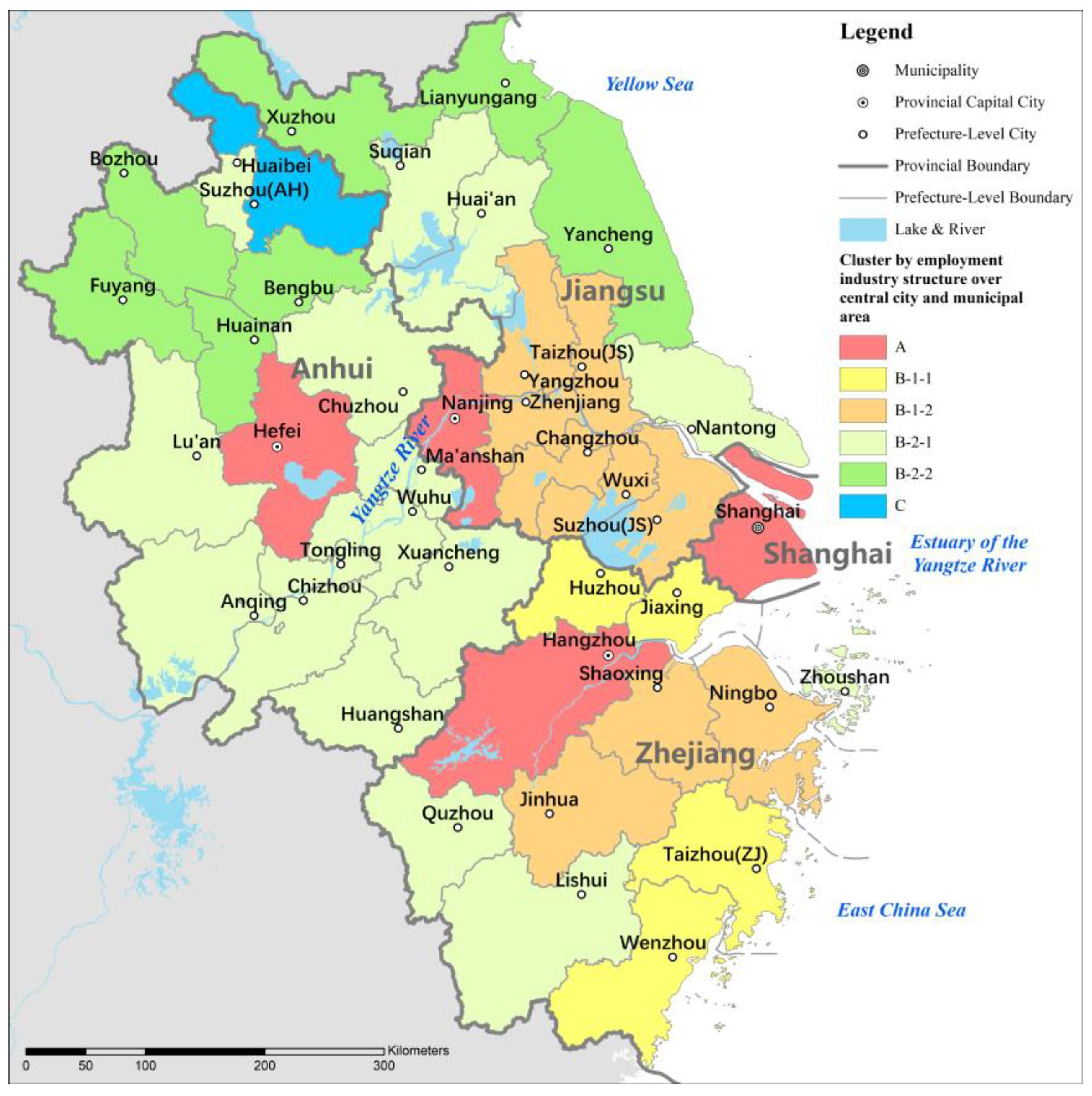

| Industry Sectors | Industry Category of Employed Population |
|---|---|
| Primary Industry | Agriculture, forestry, animal husbandry and fishery |
| Secondary Industry | Mining; manufacturing; electricity, heat, gas and water production and supply; construction |
| Tertiary Industry | Wholesale and retail trade; transportation, storage and postal services; accommodation and catering; information transmission, software and information technology services; finance; real estate; rental and business services; scientific research and technical services; water, environment and public facilities management; residential services, repairs and other services; Education; health and social work; culture, sports and entertainment; public administration, social security and social organizations; international organizations |
Disclaimer/Publisher’s Note: The statements, opinions and data contained in all publications are solely those of the individual author(s) and contributor(s) and not of MDPI and/or the editor(s). MDPI and/or the editor(s) disclaim responsibility for any injury to people or property resulting from any ideas, methods, instructions or products referred to in the content. |
© 2023 by the author. Licensee MDPI, Basel, Switzerland. This article is an open access article distributed under the terms and conditions of the Creative Commons Attribution (CC BY) license (https://creativecommons.org/licenses/by/4.0/).
Share and Cite
Chen, C. Changes in the Spatial Distribution of the Employed Population in the Yangtze River Delta Region since the 21st Century: An Analysis and Discussion Based on Census Data. Land 2023, 12, 1249. https://doi.org/10.3390/land12061249
Chen C. Changes in the Spatial Distribution of the Employed Population in the Yangtze River Delta Region since the 21st Century: An Analysis and Discussion Based on Census Data. Land. 2023; 12(6):1249. https://doi.org/10.3390/land12061249
Chicago/Turabian StyleChen, Chen. 2023. "Changes in the Spatial Distribution of the Employed Population in the Yangtze River Delta Region since the 21st Century: An Analysis and Discussion Based on Census Data" Land 12, no. 6: 1249. https://doi.org/10.3390/land12061249
APA StyleChen, C. (2023). Changes in the Spatial Distribution of the Employed Population in the Yangtze River Delta Region since the 21st Century: An Analysis and Discussion Based on Census Data. Land, 12(6), 1249. https://doi.org/10.3390/land12061249







